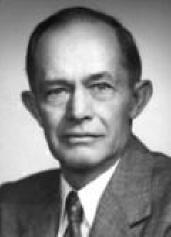
Born: November 23, 1890
Died: May 21, 1956
Terms: November 3, 1943 - May 21, 1956
Born in Louisville, Alabama, Curtis Hixon attended the public schools in Louisville, Alabama. After graduating from high school, he majored in pharmacology at the School of Pharmacy in Atlanta, Georgia. In 1914, Hixon moved to Tampa where he became a pharmacist along with his older brother Marvin. Curtis Hixon married Lila Yantis of Sebring, Florida and they had two children: Joann and Elaine. During World War I, Curtis Hixon enlisted in the U.S. Navy as a pharmacist's mate. After the war, he returned to Tampa and purchased the King's Drugstore on Franklin Street.
Interested in politics, Hixon served on the Tampa City Council from 1929 through 1937 when he resigned his position. In 1939, he was elected to the Hillsborough County Commission as the representative of the Sulphur Springs and Seminole Heights Districts. During his tenure, Hixon took an active role in laying out the street plans for the Sulphur Springs area. Curtis Hixon first campaigned for mayor of Tampa in 1943 against the three-term incumbent mayor, Robert Chancey. Hixon won the election by the largest majority in Tampa's history. He ran for re-election in 1947, 1951 and 1955, and in each election won by a substantial majority.
During his first term, Hixon was faced with numerous problems caused by the rationing of gasoline, meat and other products during World War II although the city did begin to prosper from Federal defense contracts. There were other serious issues such as rampant prostitution, venereal disease, illegal gambling, and an ever-increasing demand for city services. At the same time, the City Treasury could not support the growing demands placed on it by the citizens. In response, Hixon eliminated tax adjustments, adhered to a policy of more frequent audits and collection of overdue taxes. He also instituted two-hour training sessions for Tampa policemen under the supervision of a University of Florida professor.
With the end of World War II, Tampa moved into a period of great expansion and prosperity. Under Hixon's leadership, Drew Field was transferred to the City on October 15, 1947 after being deactivated and is now Tampa International Airport. In August 1949, Tampa purchased seven hundred twenty additional acres adjacent to the airport from the federal government for the further expansion and development of the airport.
In 1947, Tampa also acquired the former McCloskey and Company facilities at Hooker's Point and subsequent expansion made Tampa's port one of the nation's largest in tonnage carried. In 1953, the City annexed Sulphur Springs, Rocky Point and the surrounding areas up to and including Fowler Avenue which increased Tampa's population by 91,000. In 1956, the 2,000-acre Henderson Field Air Training Base was acquired to establish the University of South Florida and Tampa Industrial Park.
Hixon also implemented an enormous expansion of the water and sewer systems in Tampa, provided better equipment to the police and fire departments. He also assumed a leading role in the City's urban renewal and redevelopment projects. In 1949, the City of Tampa's charter was revised to expand the mayor's duties and administrative powers to include budget preparation and the negotiation of sewer, water, seawall and other city contracts.
On May 11, 1956, Mayor Hixon was hospitalized for pneumonia and died of heart failure on May 21, 1956. In recognition of his dedication, an auditorium and convention center beside the Hillsborough River were named in his honor. This area is now known as Curtis Hixon Waterfront Park.
Sources for this Biographical Sketch:
Covington, Dr. James W. and Wavering, Debbie Lee, "The Mayors of Tampa: A Brief Administrative History," Tampa, FL: University of Tampa, 1987.
Grismer, Karl H., Tampa: A History of the City and the Tampa Bay Region of Florida, St. Petersburg Printing Company, FL, 1950.
Photo from The Tampa Tribune
Tampa Council Minutes, City of Tampa Archives, Tampa, FL
October 19, 1943 - October 28, 1944 Roll # 22
October 28, 1944 - October 16, 1945 Roll # 23
October 16, 1945 - August 20, 1946 Roll # 24
August 20, 1946 - May 27, 1947 Roll # 25
June 3, 1947 - May 11, 1948 Roll # 26
May 18, 1948 - May 10, 1949 Roll #27
May 17, 1949 - November 29, 1949 # 28
December 6, 1949 - March 28, 1950 # 29
April 4, 1950 - January 16, 1951 # 30
January 23, 1951 - November 20, 1951 # 31
January 26, 1956 - July 31, 1956 # 38
Tampa Tribune, May 22nd and 24th, 1956: Obituary
